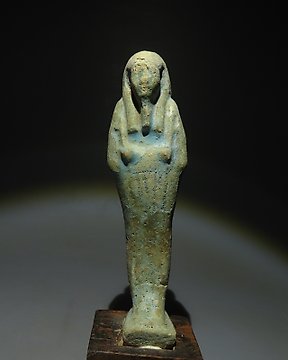
Antiguo Egipto Fayenza Shabti. Período Tardío 664-332 a.C. 11 cm H. Licencia de Exportación Española.
N.º 82450035

N.º 82450035

sema tawi
Shabtis or ushabtis are among the most numerous of all Egyptian antiquities, as they played a major role in funeral rites. Indeed, they were intended to act as servants for the deceased and to perform any manual labor for their master in the afterlife. For this to be possible, it was necessary that each shabti present in the grave had the name of their master inscribed on it and also a summoning spell to which they responded. In fact, shabti – or ushabti – translates as “the answerer”. Such figurines could also be inscribed with passages from the Book of the Dead, the intention of which was to secure safety for the deceased in the afterlife.
The name Sematawi (also seen as Semataui) appears on shabtis of this design, but also with those that include chapter 6 of the Book of the Dead. The name Sematawi means 'Uniter of the Two Lands' and was associated with a falcon-headed god, Her Sema Tawy. The Greek version of this name was Harsomtes and he was considered a child of Horus and Hathor/Isis. In Herakleopolis, the god was worshiped as two separate entities, Horus and Somtes.
The vertical bar of hieroglyphs begins with two signs, the duck sign and a crude 'child' sign. The duck sign translates as son while the second sign, translates as Srj or Sheri. Most translations label this as the father's name, however it also translates as 'child'. Thus, the shabti could only mention Sematawi's mother's name.
To discover more about Egyptian shabtis, please visit our relevant blog post: How Ancient Egyptian Shabtis and Funerary Statues Watched Over the Dead.
A very finely modeled Ancient Egyptian turquoise glazed faience shabti, featuring a dorsal pillar to the reverse. The shabti is shown wearing a tripartite wig and a false beard and holding a pick and a hoe in his crossed arms, the right arm crossing over the left. A basket hangs behind him on his left shoulder. The body has been inscribed with hieroglyphs in a T-shaped bar formation. The molded details remain very well preserved, with very clear facial features and hieroglyphs.
Ex private collection S, W, London 1974, L.K 1980 Deutschland
The seller guarantees that he acquired this piece according to all national and international laws related to the ownership of cultural property. Provenance statement seen by Catawiki.
The seller will take care that any necessary permits, like an export license will be arranged, he will inform the buyer about the status of it if this takes more than a few days
Cómo comprar en Catawiki
1. Descubre algo especial
2. Haz la puja más alta
3. Paga de manera segura